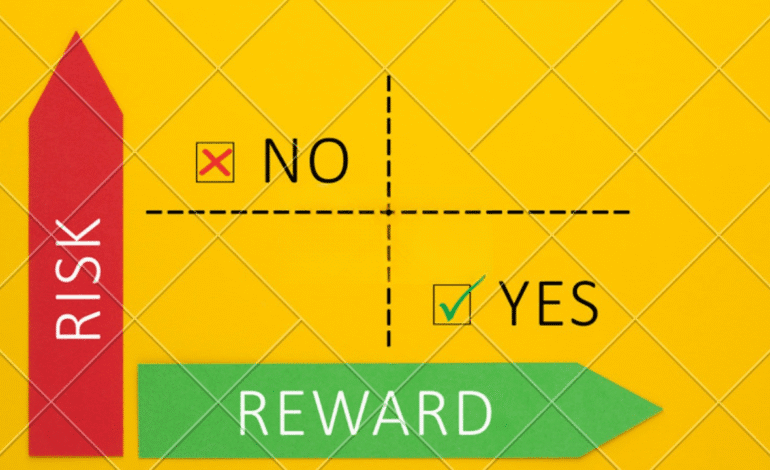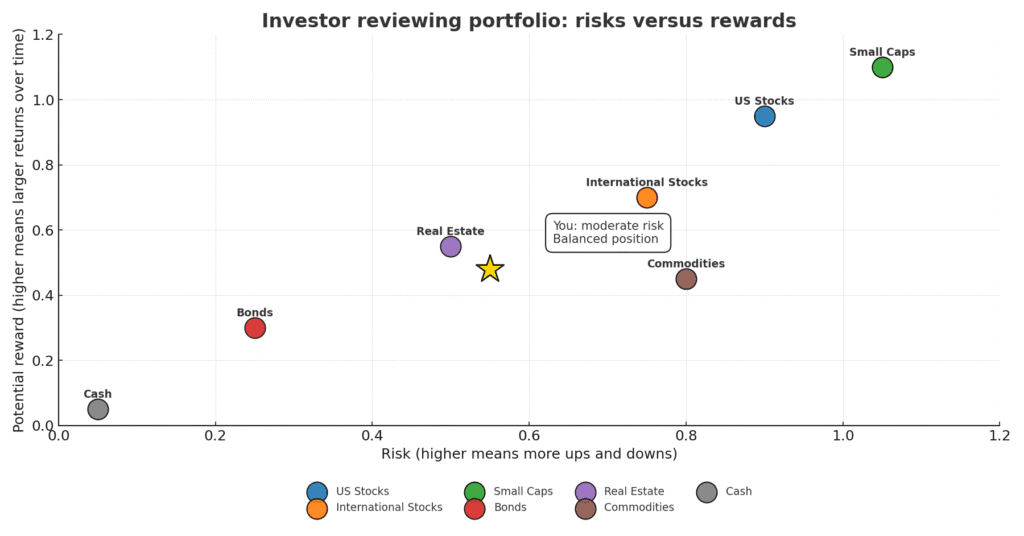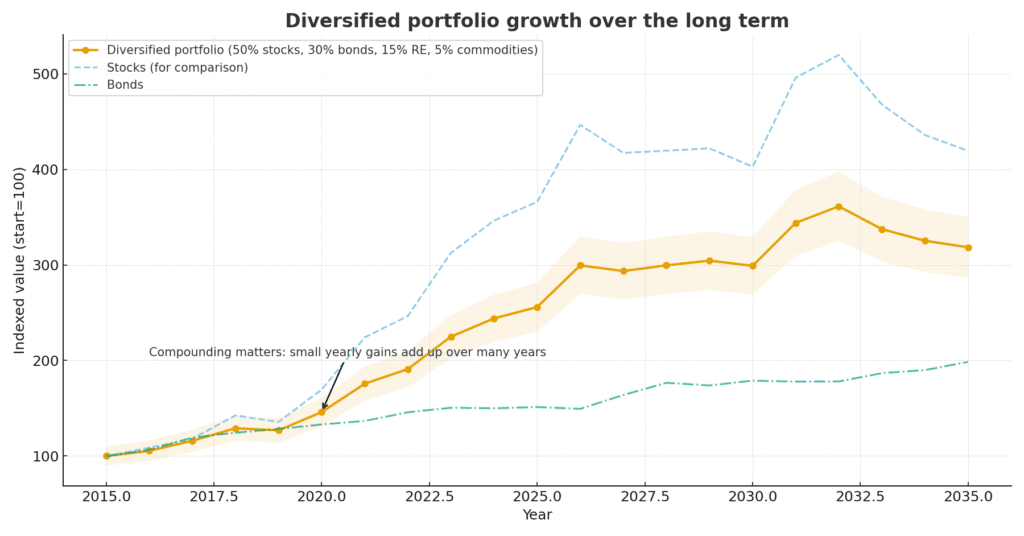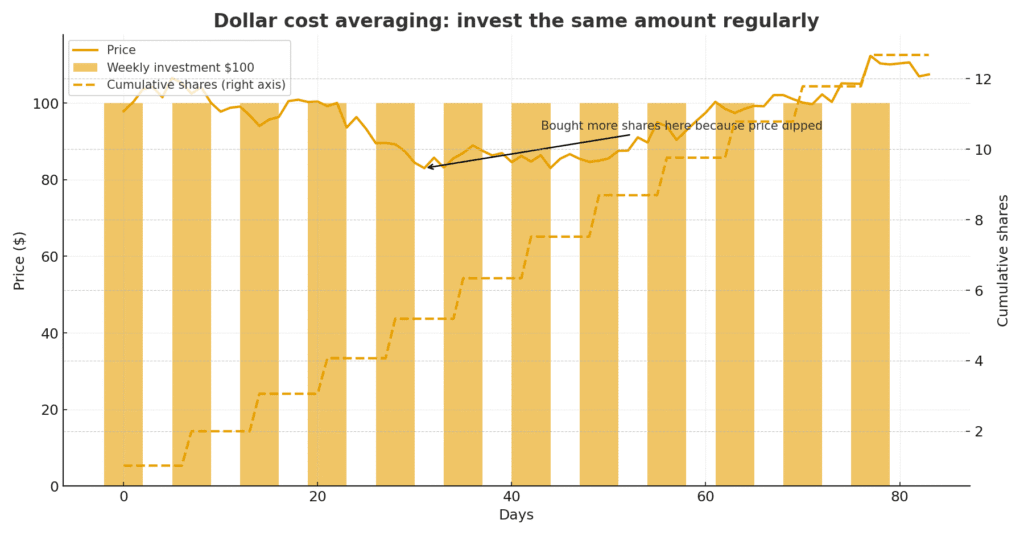
Why Understanding Risks vs Rewards Matters
Investing can feel like navigating a maze, especially for beginners. You might wonder, “Is it too risky?” or “Will I lose my hard-earned money?” The truth is, understanding risks vs rewards in investing is essential before you start putting money in stocks, bonds, or funds.
Investing is not just about numbers; it’s about building confidence, planning strategically, and making informed decisions. Whether you live in the US, UK, Canada, Singapore, or Australia, grasping these concepts helps you align financial goals with your tolerance for uncertainty.
In this comprehensive guide, we will explore 7 key insights that will help you evaluate risk, understand reward potential, and create a strategy that works for your personal circumstances. By the end, you will be equipped to make smarter investment decisions and grow wealth steadily over time.

Insight 1: Know Your Risk Appetite
Every investor has a unique tolerance for risk. Understanding this is the first step to balancing risks and rewards.
- High risk tolerance: Comfortable with volatility and potential short-term losses for higher long-term gains.
- Moderate risk tolerance: Prefers a balanced approach with a mix of growth and stable investments.
- Low risk tolerance: Prioritizes capital preservation, often leaning toward bonds, cash, or dividend-paying stocks.
Example: A 25-year-old investing for retirement might choose a high-risk portfolio with 80% stocks and 20% bonds. Conversely, a 55-year-old nearing retirement may favor 50% bonds and 50% stocks to protect capital.
Tip: Take online risk assessment quizzes or consult financial advisors to understand your personal risk profile.
Insight 2: Understand Different Asset Classes
Knowing where to invest is critical. Each asset class carries different levels of risk and potential reward:
- Stocks: High growth potential but volatile. Includes blue-chip companies for more stability.
- Bonds: Lower risk with fixed income. Government bonds are safest, corporate bonds offer higher yield.
- Mutual Funds & ETFs: Pooled investment vehicles offering diversification and professional management.
Example: Investing in a diversified S&P 500 ETF can spread risk across hundreds of companies, providing a smoother growth path than a single stock.
Tip: Start with a mix of stocks and bonds aligned with your risk tolerance. ETFs are ideal for beginners because they provide instant diversification.
Insight 3: Diversification is Your Safety Net
Diversification means spreading investments across different asset types, sectors, and regions. It is one of the most powerful tools to reduce risk while preserving growth potential.
- Why it matters: If one investment underperforms, others can balance the loss.
- Example: Combining 50% US stocks, 30% bonds, and 20% international equities can reduce volatility while maintaining growth potential.
- Pro Tip: Don’t just diversify across asset classes; diversify across industries, such as technology, healthcare, and consumer goods.

Insight 4: Time Horizon Influences Risk and Reward
Your investment timeline significantly impacts your risk-taking strategy. Longer horizons allow for more aggressive growth, while shorter horizons demand caution.
- Short-term goals (0–3 years): Preserve capital with low-risk investments like bonds, money market funds, or high-interest savings accounts.
- Medium-term goals (3–10 years): Balanced portfolio with a mix of stocks and bonds.
- Long-term goals (10+ years): Focus on growth through equities, ETFs, and global diversification.
Example: If you are saving for retirement at age 30, you have decades to ride out market fluctuations, making stock-heavy portfolios more suitable. Conversely, if you plan to buy a house in 3 years, prioritize safer, more liquid investments.
Tip: Always match your investment choices to your time horizon. Longer timelines tolerate volatility, which can increase potential rewards.
Insight 5: Dollar-Cost Averaging Reduces Risk
Dollar-cost averaging (DCA) is a strategy where you invest a fixed amount regularly, regardless of market conditions. This method reduces the risk of investing a large sum at the wrong time.
- How it works: Invest $500 monthly in an ETF. When prices are high, you buy fewer shares. When prices are low, you buy more shares. Over time, the average cost per share smooths out.
- Benefits: Reduces emotional decision-making and avoids market timing pitfalls.
- Example: Over ten years, a consistent DCA strategy in the S&P 500 can yield higher returns than trying to time peak and trough periods.
Pro Tip: Automate investments using brokerage platforms that allow monthly contributions. This ensures discipline and avoids procrastination.

Insight 6: Real-World Examples of Risks vs. Rewards
Examining actual investment outcomes highlights the importance of risk management and diversification.
- Scenario 1: Investor A invests heavily in a single tech stock during a market boom. The stock initially skyrockets, but a sector downturn causes massive losses. This illustrates high reward potential but significant risk.
- Scenario 2: Investor B invests in a diversified ETF spanning multiple sectors and regions. Returns are steady, and losses in one sector are offset by gains in others.
Lesson: High-risk investments can yield fast gains, but losses can be equally fast. Diversification and strategic planning stabilize long-term results.
Example Chart/Visual: Include an image showing a single-stock portfolio vs a diversified ETF portfolio over 10 years.
- Alt text: Risks vs rewards investing single stock versus diversified portfolio chart
Pro Tip: Even seasoned investors maintain diversified portfolios. Avoid chasing hot stocks without considering risk.
Insight 7: Long-Term Wealth Building Requires Mindset and Habits
Understanding risks vs. rewards in investing is not enough. Long-term success depends on cultivating the right mindset and consistent habits.
Patience and Discipline
Investing is a marathon, not a sprint. Markets fluctuate, but disciplined investors focus on long-term goals.
- Avoid reacting to every market headline.
- Stick to your investment plan during volatility.
- Use setbacks as learning opportunities, not panic triggers.
Example: Legendary investor Warren Buffett emphasizes, “The stock market is a device for transferring money from the impatient to the patient.”
Regular Portfolio Review
Checking your investments periodically ensures alignment with goals and risk tolerance.
- Rebalance your portfolio once or twice a year.
- Adjust allocations if life circumstances or market conditions change.
Pro Tip: Avoid frequent changes based on short-term news. Long-term consistency matters more than timing the market.
Continuous Learning
Financial literacy is ongoing. New investment options, market trends, and regulations appear constantly.
- Follow authoritative sources like JP Morgan Asset Management and Stock and Insurance.
- Attend webinars, read guides, and track market developments.
- Start small and gain experience gradually.
Risk Assessment and Life Stage
Risk tolerance evolves with age and financial responsibilities.
- Early Career: Higher risk, aggressive growth strategies.
- Mid-Life: Balance growth and safety with a mix of stocks and bonds.
- Pre-Retirement: Focus on capital preservation with conservative investments.
Example: A 30-year-old may invest 70% in equities. By 55, shift toward 50% equities and 50% bonds.
Emergency Fund First
Before investing aggressively, maintain 6–12 months of living expenses in liquid assets.
- Protects against forced asset sales during market dips.
- Keep funds in low-risk instruments like savings accounts or short-term deposits.
Diversification and Global Exposure
Global diversification reduces risk and exposes your portfolio to multiple growth opportunities.
- Equities: Mix domestic and international stocks.
- Funds: ETFs tracking S&P 500, FTSE 100, ASX 200.
- Alternatives: Gold, real estate, or REITs.
Example: An MSCI World ETF provides exposure to hundreds of companies worldwide, spreading risk across sectors and geographies.
Psychology of Investing
Behavioral finance impacts decision-making:
- Loss Aversion: Fear of losses can prevent investing. Focus on long-term gains.
- Overconfidence: Avoid assuming you can predict markets perfectly.
- Anchoring Bias: Do not base decisions solely on past performance; focus on fundamentals.
Real-Life Example: Compounding Growth
Investor A contributes $500 per month for 20 years at 8% growth:
- Total invested: $120,000
- Portfolio value: ~$310,000
Investor B starts 10 years later, investing $500 per month for 10 years at the same return:
- Total invested: $60,000
- Portfolio value: ~$108,000
Lesson: Time in the market is more important than timing the market. Start early and stay consistent.
Conclusion: Bringing It All Together
7 Key Insights Recap:
- Understand your risk appetite.
- Know different asset classes.
- Diversify to reduce volatility.
- Match investments to your time horizon.
- Use strategies like dollar-cost averaging.
- Learn from real-world investment examples.
- Build long-term wealth with the right mindset, habits, and global exposure.
By applying these insights, investors in Tier 1 countries like the US, UK, Canada, Singapore, and Australia can confidently navigate markets, manage risk, and pursue sustainable wealth growth.
Is it too late to start investing if I am 40?
No. You can still grow wealth, but asset allocation should focus more on capital preservation and moderate growth.
Should I invest only in my home country?
Global diversification can reduce risk and capture growth opportunities worldwide.
How do I decide between stocks and bonds?
It depends on your risk tolerance and investment horizon. Younger investors favor stocks; older investors tilt toward bonds.



